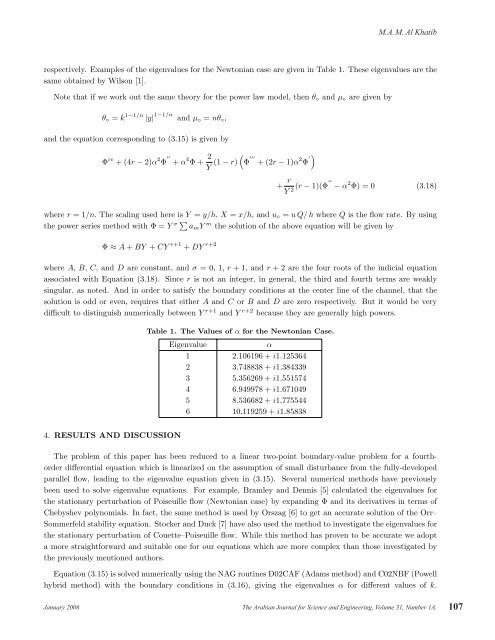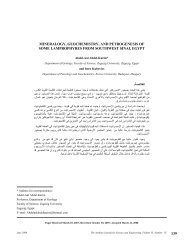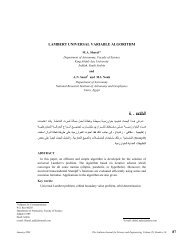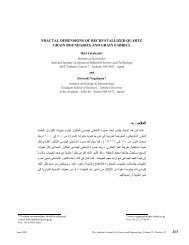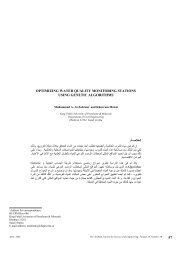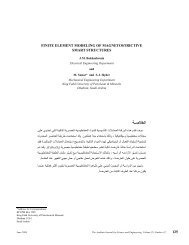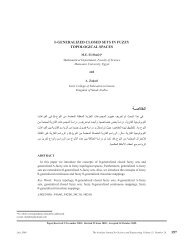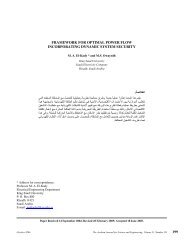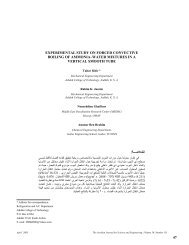the development of poiseuille flow of a pseudoplastic fluid
the development of poiseuille flow of a pseudoplastic fluid
the development of poiseuille flow of a pseudoplastic fluid
You also want an ePaper? Increase the reach of your titles
YUMPU automatically turns print PDFs into web optimized ePapers that Google loves.
M.A.M. Al Khatib<br />
respectively. Examples <strong>of</strong> <strong>the</strong> eigenvalues for <strong>the</strong> Newtonian case are given in Table 1. These eigenvalues are <strong>the</strong><br />
same obtained by Wilson [1].<br />
Note that if we work out <strong>the</strong> same <strong>the</strong>ory for <strong>the</strong> power law model, <strong>the</strong>n θ◦ and µ◦ are given by<br />
θ◦ = k 1−1/n |y| 1−1/n and µ◦ = nθ◦,<br />
and <strong>the</strong> equation corresponding to (3.15) is given by<br />
Φ iv +(4r − 2)α 2 Φ ′′<br />
+ α 4 Φ+ 2<br />
<br />
(1 − r) Φ<br />
Y ′′′<br />
+(2r− 1)α 2 Φ ′<br />
+ r<br />
(r − 1)(Φ′′ − α<br />
Y 2 2 Φ) = 0 (3.18)<br />
where r =1/n. The scaling used here is Y = y/h, X = x/h, andu◦ = uQ/h where Q is <strong>the</strong> <strong>flow</strong> rate. By using<br />
<strong>the</strong> power series method with Φ = Y σ amY m <strong>the</strong> solution <strong>of</strong> <strong>the</strong> above equation will be given by<br />
Φ ≈ A + BY + CY r+1 + DY r+2<br />
where A, B, C, and D are constant, and σ =0, 1, r+1, and r + 2 are <strong>the</strong> four roots <strong>of</strong> <strong>the</strong> indicial equation<br />
associated with Equation (3.18). Since r is not an integer, in general, <strong>the</strong> third and fourth terms are weakly<br />
singular, as noted. And in order to satisfy <strong>the</strong> boundary conditions at <strong>the</strong> center line <strong>of</strong> <strong>the</strong> channel, that <strong>the</strong><br />
solution is odd or even, requires that ei<strong>the</strong>r A and C or B and D are zero respectively. But it would be very<br />
difficult to distinguish numerically between Y r+1 and Y r+2 because <strong>the</strong>y are generally high powers.<br />
4. RESULTS AND DISCUSSION<br />
Table 1. The Values <strong>of</strong> α for <strong>the</strong> Newtonian Case.<br />
Eigenvalue α<br />
1 2.106196 + i1.125364<br />
2 3.748838 + i1.384339<br />
3 5.356269 + i1.551574<br />
4 6.949978 + i1.671049<br />
5 8.536682 + i1.775544<br />
6 10.119259 + i1.85838<br />
The problem <strong>of</strong> this paper has been reduced to a linear two-point boundary-value problem for a fourthorder<br />
differential equation which is linearized on <strong>the</strong> assumption <strong>of</strong> small disturbance from <strong>the</strong> fully-developed<br />
parallel <strong>flow</strong>, leading to <strong>the</strong> eigenvalue equation given in (3.15). Several numerical methods have previously<br />
been used to solve eigenvalue equations. For example, Bramley and Dennis [5] calculated <strong>the</strong> eigenvalues for<br />
<strong>the</strong> stationary perturbation <strong>of</strong> Poiseuille <strong>flow</strong> (Newtonian case) by expanding Φ and its derivatives in terms <strong>of</strong><br />
Chebyshev polynomials. In fact, <strong>the</strong> same method is used by Orszag [6] to get an accurate solution <strong>of</strong> <strong>the</strong> Orr–<br />
Sommerfeld stability equation. Stocker and Duck [7] have also used <strong>the</strong> method to investigate <strong>the</strong> eigenvalues for<br />
<strong>the</strong> stationary perturbation <strong>of</strong> Couette–Poiseuille <strong>flow</strong>. While this method has proven to be accurate we adopt<br />
a more straightforward and suitable one for our equations which are more complex than those investigated by<br />
<strong>the</strong> previously mentioned authors.<br />
Equation (3.15) is solved numerically using <strong>the</strong> NAG routines D02CAF (Adams method) and C02NBF (Powell<br />
hybrid method) with <strong>the</strong> boundary conditions in (3.16), giving <strong>the</strong> eigenvalues α for different values <strong>of</strong> k.<br />
January 2006 The Arabian Journal for Science and Engineering, Volume 31, Number 1A. 107


